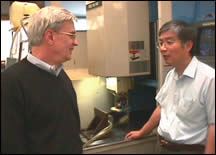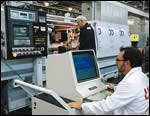Optimizing The Grinding Process
R&D project aims to change grinding from an art to a science.
Share





The grinding process involves more variables—type of grinding wheel, wheel speed, infeed rate, wheel dressing frequency, dressing method, type of coolant and so forth—than most other metalworking processes. There are so many variables, in fact, that controlling the grinding process has come to be viewed as an art more than an exact science—a task best handled by a skilled grinding machine operator with years of experience.
That may change, however, as a result of a research and development program intended to provide “intelligent optimization and control of grinding processes.” The R&D project is a joint venture involving several companies involved with grinding. It was chosen by the National Institute of Standards and Technology (NIST) as a recipient of its 2002 Advanced Technology Program (ATP) competition award. The award, announced a few months ago, provides $6 million in funding for the 3-year term of the program.
Here’s a quick rundown of what is involved. Participants in the project will develop analytical models of each of the major grinding processes—surface grinding, cylindrical grinding, centerless grinding and so forth—based on extensive studies using highly instrumented test beds. Each model will represent an extensive knowledge base for optimizing a particular grinding process. When the details of a specific grinding task—workpiece material, type of grinding wheel, dimensional tolerances, surface finish requirements and so forth—are loaded into the model, the system will determine the machine settings, wheel speed, depth of cut, dressing frequency and other parameters required to optimize the operation.
The system will be somewhat flexible: The end user will be able to ask for the settings that provide the fastest cycle time or those that provide the lowest production costs. Either way, the user starts out with the optimal parameters, eliminating the need for trial and error.
Benefits expected to result from optimized grinding processes include increased productivity; reduced expenditures on consumables; scrap and rework reduction; and improved quality. The joint venture partners conservatively estimate that optimized grinding will provide a 10 percent cost savings for U.S. grinding operations, about $1 billion annually. Perhaps more importantly, optimized grinding represents a step toward competing in a global economy using intelligent tools and proprietary processes.
The Players
- Purdue University, Lafayette, Indiana, is the technology provider for the project. Studies of the grinding process during the last 10 years by Dr. Yung C. Shin, a professor at Purdue’s School of Mechanical Engineering, provide the core technology that the joint venture partners will use to generate the knowledge base and optimize grinding processes. Dr. Shin’s work on the grinding process will continue, and results will be made available to the other joint venture partners during the term of the project.
- TechSolve, Cincinnati, Ohio, is a participant in NIST’s Manufacturing Extension Partnership (MEP), a nationwide network of technical and business assistance centers developed to help small and medium-sized manufacturers improve performance and competitiveness. The network is dedicated to improving the competitiveness of manufacturing and related businesses, particularly through improvements of their machining operations.
TechSolve explains that it will be responsible for the overall management of the research and development effort. As part of the team, it will develop the knowledge base for the surface grinding portion of the intelligent grinding project in its own laboratory. It will also assist the other partners in the development of the databases by conducting tests on different grinding test beds created at partner sites. These databases will be further used to develop the various grinding models.
- Landis Gardner, Waynesboro, Pennsylvania, a UNOVA company, is a producer of grinding machines and systems, primarily for the automotive industry. The company’s areas of expertise include advanced computer-based machine control systems, machine/sensor integration, and software tools for monitoring and controlling grinding processes—all of which are essential elements of an intelligent grinding process.
Landis will be responsible for testing of the centerless grinding process. In addition, the firm will continue its work on sensor technology—particularly force, power and acoustic emissions sensors—which is needed to provide adequate process monitoring. The firm reports that it has already done quite a bit of work in those areas independently, but that the results of its studies have not been consolidated.
- Delphi Corp., Troy, Michigan, a major manufacturer of automotive components with 48 manufacturing facilities in the U.S. and 169 worldwide, will provide real-world testing of the intelligent grinding technology and will be one of its first beneficiaries. The firm uses grinding extensively for such components as bearings, fuel injectors and valve train components, and it has very specific ideas about where it will employ the intelligent grinding technology to achieve immediate benefits. The firm expects to optimize its grinding operations to reduce costs, create more stable processes and lower scrap rates.
- Applied Grinding Technologies, Inc., Wixom, Michigan, will have responsibility for making the development work completed at Purdue available to the other project partners. In addition, the firm will be responsible for marketing intelligent grinding “products” as they become available.
Jim Greenwood, president of Applied Grinding Technologies, explains that incorporating an assortment of analytical models of grinding processes into a well-defined system poses a serious technical risk. No single company in the joint venture has the funds or expertise to develop the intelligent grinding technology on its own. The ATP funding will facilitate the collaboration effort that is needed to achieve the ambitious research and development effort that the project requires.
Selling The Process
How does AGT expect to sell intelligent grinding to the marketplace? “I view the intelligent grinding technology as a service-related product,” Mr. Greenwood notes. “We would come in as a consultant to help a company install the optimization program and train its employees to use it. Companies with engineers who have been trained in methods of analyzing problems and coming up with solutions will find the intelligent grinding technology a wonderful tool. Companies that use six sigma or ISO standards for continuous improvement will find that they can use our optimization model to get from one level to the next, as far as they want to go.”
Mr. Greenwood hastens to add that companies with leaner engineering staffs can also take advantage of intelligent grinding technology. “We can come in and optimize the company’s grinding process on a contract basis,” he explains.
Delphi Corp.’s participation in the project suggests that the intelligent grinding technology is a tool for large manufacturing companies. “Large firms use a variety of grinding processes,” explains Purdue’s Dr. Shin. “These firms feel that their processes are sub-optimal, and they have no fast way of achieving optimal conditions. This new technology will provide ways of optimizing grinding processes, thereby reducing production costs and improving the overall efficiency of the operation.”
“However, small shops will also benefit from the technology,” Dr. Shin continues. “For example, if the shop does not have an expert grinding machine operator, our system will provide the settings needed to grind a particular part correctly. The small shop also benefits from reduced leadtime, fewer scrapped parts and greater efficiency.”
While the grinding machines themselves probably won’t change much as a result of the intelligent grinding project—surface grinders, centerless grinders and other types of grinders will continue to look and function as they always have—the partners expect that the project will result in major improvements in software, machine controls and sensors.
“Once the software is ready, firms using it (off-line) will be able to input information for a specific job, such as the material being ground, the wheel being used, the machine on which the job will run and so forth, and the intelligent grinding program will provide the optimal grinding parameters for the job,” explains Dr. Anil Srivastava, TechSolve’s manager of manufacturing technology. “Any shop will be able to use the software; in fact, it will be very user friendly.
“Today, many large manufacturing firms with extensive grinding operations still rely on inefficient trial-and-error methods for their grinding operations,” Dr. Srivastava continues. “They don’t know what type of wheel is best for a particular application, when to dress the grinding wheel and what machining parameters to use. With the intelligent grinding system, all of the information will be immediately available. There’s no need to rely on the operator’s previous grinding experience to make the right choices. The software provides the numbers and the operator simply sets the machine accordingly.”
Dr. Shin predicts that the intelligent grinding project will result in major changes in CNC controls for grinders, leading to a next generation of grinding machine controls with built-in grinding expertise.
Tim Hykes, manager of controls engineering for Landis Gardner, agrees, noting that the company’s latest 6400 CNC control is already able to handle the input from sensors monitoring the grinding process as well as data from the servomotors on the machine—capabilities that will be addressed as part of the intelligent grinding R&D activities.
“We’ve done a lot with sensors in our lab over the years, and that will be the basis for the partners’ work on sensors,” says Bill Pflager, manager of R&D for Landis. “We’ll all be using fully instrumented test stands to gather data, so it will be critical to get reliable readings from our force, power, acoustic emissions and other sensors. For example, we’ll be doing all of the testing for centerless grinding at out facilities on fully instrumented machines.”
Landis is perhaps unique among the joint venture partners in that it will not only be able to incorporate some of intelligent grinding capabilities in its controls and software, but it will also be able to use the technology internally to provide customers with machines better suited to specific grinding applications. Landis president Dan Pheil explains: “Typically, when we get an order for a grinding machine, we analyze the application, gather some data, perform some testing in-house and then quote a part cycle time that becomes a part of the purchase agreement. We invest a lot of time and effort in making the machine as efficient as possible for the particular application, and even though we meet the performance levels as per our commitment to our customer, the process is probably still not all it could be when the machine is shipped.
“Now, we’ll be able to use the intelligent grinding technology as an internal tool to ship machines that are optimized for the application,” Mr. Pheil continues. “Where the need to deliver a machine or system to the customer in a timely fashion militated against trying to optimize the machine using the trial-and-error methods of the past, we’ll be able to use the intelligent grinding technology to provide an optimized machine. That’s a competitive advantage both for us and for the customer who is getting a more efficient grinding process.”
When will intelligent grinding technology be available to the metalworking industry? Dr. Shin expects some offerings to be available as early as summer 2004, and he expects that some joint venture partners, serving as consultants or turnkey suppliers, will be able to help companies install the technology by the end of the 3-year R&D project.
Read Next
Setting Up the Building Blocks for a Digital Factory
Woodward Inc. spent over a year developing an API to connect machines to its digital factory. Caron Engineering’s MiConnect has cut most of this process while also granting the shop greater access to machine information.
Read MoreRegistration Now Open for the Precision Machining Technology Show (PMTS) 2025
The precision machining industry’s premier event returns to Cleveland, OH, April 1-3.
Read MoreBuilding Out a Foundation for Student Machinists
Autodesk and Haas have teamed up to produce an introductory course for students that covers the basics of CAD, CAM and CNC while providing them with a portfolio part.
Read More




















.jpg;maxWidth=300;quality=90)













